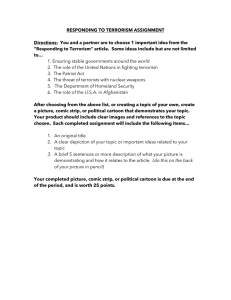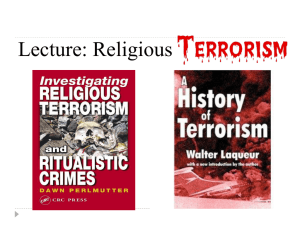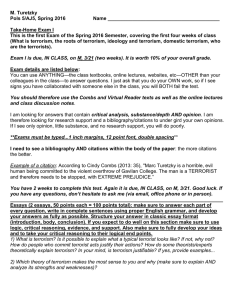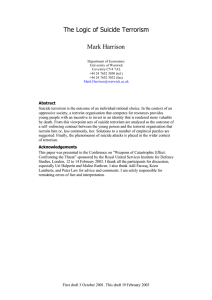Document 14573148
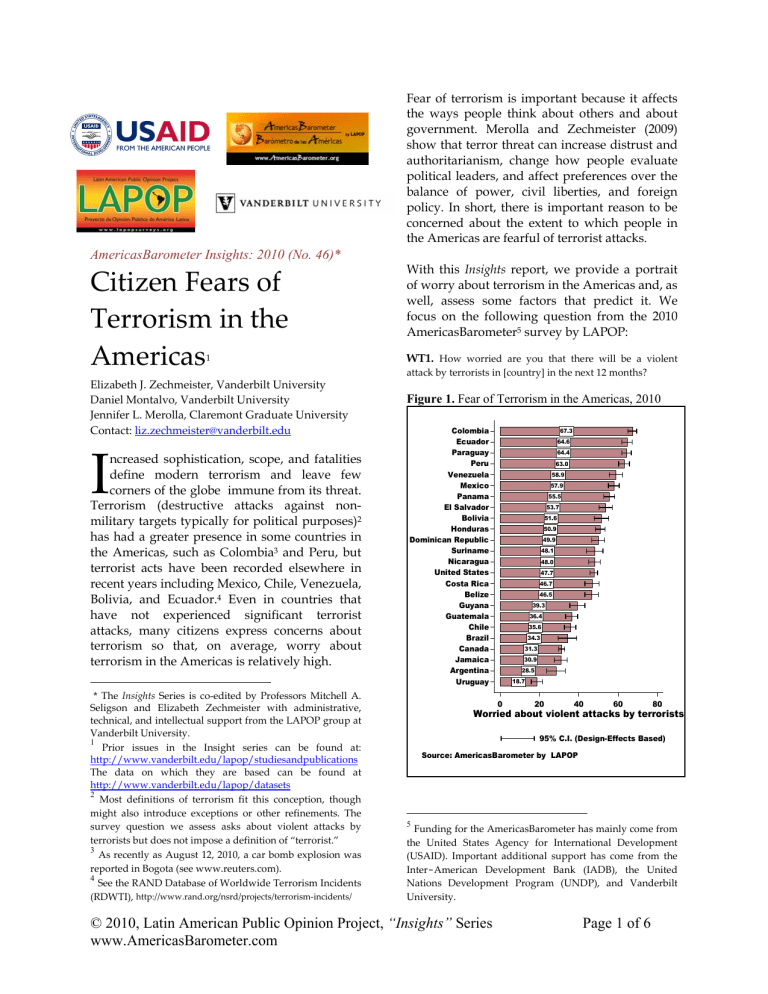
AmericasBarometer Insights: 2010 (No. 46)*
Citizen
Fears
of
Terrorism
in
the
Americas
1
Elizabeth J.
Zechmeister, Vanderbilt University
Daniel Montalvo, Vanderbilt University
Jennifer L.
Merolla, Claremont Graduate University
Contact: liz.zechmeister@vanderbilt.edu
I ncreased sophistication, scope, and fatalities define modern terrorism and leave few corners of the globe immune from its threat.
Terrorism (destructive attacks against nonmilitary targets typically for political purposes) 2 has had a greater presence in some countries in the Americas, such as Colombia 3 and Peru, but terrorist acts have been recorded elsewhere in recent years including Mexico, Chile, Venezuela,
Bolivia, and Ecuador.
4 Even in countries that have not experienced significant terrorist attacks, many citizens express concerns about terrorism so that, on average, worry about terrorism in the Americas is relatively high.
* The Insights Series is co-edited by Professors Mitchell A.
Seligson and Elizabeth Zechmeister with administrative, technical, and intellectual support from the LAPOP group at
Vanderbilt University.
1 Prior issues in the Insight series can be found at: http://www.vanderbilt.edu/lapop/studiesandpublications
The data on which they are based can be found at http://www.vanderbilt.edu/lapop/datasets
2
Most definitions of terrorism fit this conception, though might also introduce exceptions or other refinements.
The survey question we assess asks about violent attacks by
3 terrorists but does not impose a definition of “terrorist.”
As recently as August 12, 2010, a car bomb explosion was reported in Bogota (see www.reuters.com).
4
See the RAND Database of Worldwide Terrorism Incidents
(RDWTI), http://www.rand.org/nsrd/projects/terrorism ‐ incidents/
Fear of terrorism is important because it affects the ways people think about others and about government. Merolla and Zechmeister (2009) show that terror threat can increase distrust and authoritarianism, change how people evaluate political leaders, and affect preferences over the balance of power, civil liberties, and foreign policy. In short, there is important reason to be concerned about the extent to which people in the Americas are fearful of terrorist attacks.
With this Insights report, we provide a portrait of worry about terrorism in the Americas and, as well, assess some factors that predict it. We focus on the following question from the 2010
AmericasBarometer 5 survey by LAPOP:
WT1.
How worried are you that there will be a violent attack by terrorists in [country] in the next 12 months?
Figure 1. Fear of Terrorism in the Americas, 2010
Colombia
Ecuador
Paraguay
Peru
Venezuela
Mexico
Panama
El Salvador
Bolivia
Honduras
Dominican Republic
Suriname
Nicaragua
United States
Costa Rica
Belize
Guyana
Guatemala
Chile
Brazil
Canada
Jamaica
Argentina
Uruguay
36.4
35.6
34.3
31.3
47.7
46.7
46.5
39.3
50.9
49.9
48.1
48.0
57.9
55.5
53.7
51.6
67.3
64.6
64.4
63.0
58.9
30.9
18.7
28.5
0 20 40 60 80
Worried about violent attacks by terrorists
95% C.I. (Design-Effects Based)
Source: AmericasBarometer by LAPOP
5
Funding for the AmericasBarometer has mainly come from the United States Agency for International Development
(USAID).
Important additional support has come from the
Inter American Development Bank (IADB), the United
Nations Development Program (UNDP), and Vanderbilt
University.
© 2010, Latin American Public Opinion Project, “Insights” Series Page 1 of 6 www.AmericasBarometer.com
Figure 1 shows mean responses (with confidence intervals) by country to this question, with responses recalibrated on a 0-100 scale, where 0 means “Not at all worried” and 100
“Very worried”.
6 The question also included an explicit option for those who “haven’t thought much about this”; those who responded that way are not included in this scale.
7
Mean levels of worry about terrorist attacks, as shown in Figure 1, are above the 50-unit midpoint on the scale in ten of the 24 countries. Not surprisingly, Colombia and Peru, two countries that have suffered from numerous terrorist attacks, are found in the top tier of the list of countries, with mean levels of worry of 67.3 and
63.0, respectively. The RDWTI (see footnote 3) reports 46 attempted and/or successful terrorist attacks in Colombia in 2009, most of which are attributed to the FARC. Fewer incidents were reported in Peru, but the country has nonetheless continued to see occasional attacks, typically attributed to the Shining Path, which serve as reminders of much greater levels of terrorism in the 1990s.
Interestingly, Ecuador and Paraguay are at the top of the list, suggesting high levels of concern about security in those countries; in at least the former case, this may be due to concerns about
FARC activity within Ecuador’s borders. In direct contrast to these cases, levels of worry are strikingly low in Jamaica, Argentina, and especially Uruguay. While some might expect the United States to place higher, its placement in the middle of the scale makes sense in light of the fact that economic decline rivaled for the public’s attention in 2010, while the public’s concern about terrorism likely had been dulled by nearly nine years of repeated terror alerts typically followed by little to no sign of terrorist
6 Mean non-response for this question was 5.3%.
7 The percentage of individuals who responded that they
“haven’t thought much about this” is 22.99 percent;
Appendix Table A1 provides a breakdown by country. If we instead code these respondents to the “not at all worried” category, the relative ranking of mean values across the countries remains fairly stable, as do the results presented later in this report (more information available upon request from the authors). To take into account the large number of
“missing values,” we employ the “subpopulation” command in STATA to correctly compute the standard errors of the complex sample design. activity. The values in Figure 1 and relative rankings remain fairly stable even if individual characteristics are taken into account, as we do for the Latin American and Caribbean cases in
Appendix Figure A2.
What determines variation in levels of worry about terrorism in the Americas? The above analysis and discussion suggest that country context matters, and it is possible that individual characteristics do as well. In the next section we take a closer look at determinants of worry about terrorism in the Americas.
The Rule of Law Helps Reduce
Citizens’ Worries about Terrorism
Among the country level factors that may influence worry about terrorism, we suggest that the rule of law matters. The stronger the rule of law, the more protected citizens should feel from violence by terrorists or others. A weak rule of law could create a climate that foments extremist views and/or might act as a proxy for state failures in the realm of the provision of security. The Freedom House organization provides a measure of the rule of law, which is operationalized using the following questions: (1) Is there an independent judiciary? (2) Does the rule of law prevail in civil and criminal matters? Are police under direct civilian control? (3) Is there protection from political terror, unjustified imprisonment, exile, or torture, whether by groups that support or oppose the system? Is there freedom from war and insurgencies? and (4) Do laws, policies, and practices guarantee equal treatment of various segments of the population?
8
In addition to country context, characteristics of individuals and the neighborhoods where they live can explain variation in levels of worry about terrorist attacks. We expect worry about crime (perception of neighborhood insecurity) to correlate with worry about terrorist attacks, as the latter is a subset of the former. We also expect that those who have been previously
8
See: http://www.freedomhouse.org/template.cfm?page=351&a na_page=341&year=2008 Last accessed on 07-20-10.
© 2010, Latin American Public Opinion Project, “Insights” Series Page 2 of 6 www.AmericasBarometer.com
victimized by crime, or have a household member who was victimized, will be more concerned about the possibility of a violent attack by terrorists. In terms of political ideology, we expect that those on the right will be more worried about violent acts, in part because Latin American guerrillas are usually considered to the left.
9 Those with relatives abroad may have heighted perceptions of the risk posed by terrorism, given the prevalence of discussions about terrorism as well as terrorist incidents in both the United States and Europe, where most members of the Latin American and
Caribbean diasporas reside. We also control for basic socio-economic and demographic factors.
10
With these measures, we predict fear of terror with a multi-level model, and the results are presented in Figure 2. In the figure, each variable included in the analysis is listed on the vertical (y) axis. The impact of each of those variables on fear of terror is shown graphically by a dot, which if located to the right of the vertical “0” line indicates a positive contribution, and if to the left of the “0” line a negative contribution. Statistically significant contributors are shown by confidence interval lines stretching to the left and right of each dot; only when the confidence intervals do not overlap the vertical “0” line is the variable significant (at .05 or better). The relative strength of each variable is indicated by standardized coefficients (i.e., “beta weights”).
Figure 2. A Multilevel Analysis of the Determinants of Fear of Terrorist Attacks, 2010
11
Size of the Place of Residence
Quintiles of wealth
Age
Female
Education
Percep. Family Econ. Sit.
Relatives living abroad
Left-Right Ideology
Perception of Insecurity
Household Member Victimized by Crime
Crime Victimization
FH's Rule of Law
N. of Obs.: 26,730
N. of Countries: 22
-0.3
-0.2
-0.1
95% C.I.
0.0
0.1
Source: AmericasBarometer by LAPOP and Freedom House 2010
The results in Figure 2 show that those who live in smaller towns and/or more rural areas, those who are poorer, less educated, and who perceive of their own economic situation in a relatively worse light are more concerned about terrorism. Likely this reflects an important reality of terrorism: the typical terrorist attack in the Americas inflicts more harm on groups of individuals who are marginalized in these ways.
We see also that women are far more concerned than men and, as we expected, those with relatives abroad are more worried about terrorism. We suggest this latter result reflects a transmission of information from places abroad where the threat of terrorism on a daily basis is more palpable than it is in most countries in
Latin America and the Caribbean. As expected, our variables measuring crime victimization, insecurity, and having an ideology to the right
9 Examples of guerrilla groups considered on the left include the FARC, ELN, Revolutionary Movement Tupac-Amaru,
Shining Path, Tupamaros, and Alfaro Vive Carajo.
10 These factors are: (a) “Size of the City/Town of
Residence,” which runs from 1 (Rural Area) to 5 (National
Capital); (b) “Quintiles of Wealth,” which runs from 1 (Least
Wealth) to 5 (Most Wealth); (c) “Age,” which runs from 18
(16 in the case of Nicaragua) to 98 years of age; (d) “Female,” coded 1 for women and 0 for men; and (e) “Education,” which runs from 0 to 18 years of completed education.
11
In this model, we tried to include other theoretically relevant variables, such as “trust in the military” and “trust in the national government;” however, the coefficients were not statistically significant. We also included a question on personality, and found that those who consider themselves as critical and quarrelsome are more worried about violent attacks by terrorists. However, we do not include it in the model because that variable was not part of the Honduras questionnaire, and its exclusion does not change the significance and direction of the other coefficients. Also, we excluded the US and Canada from this model due to our focus in Latin America and the Caribbean and the lack of availability of some of the control variables.
© 2010, Latin American Public Opinion Project, “Insights” Series Page 3 of 6 www.AmericasBarometer.com
of the scale center 12 are positively related to worry about terrorism.
Turning to the country-level indicator that we included, a country’s level of rule of law is indeed associated with worry about terrorism.
Citizens in countries with lower rankings on the
Freedom House Rule of Law scale are more worried about terrorism than citizens in countries where the rule of law is more secured.
In short, the ability of a state to maintain wellfunctioning courts and security forces that ensure rights and oversee a relatively peaceful citizenry is key to promoting perceptions of protection from the threat of terrorism.
Conclusion
In this brief report, we have provided a portrait of concern about terrorism in the Americas.
Worry about the threat of violent attacks by extremist individuals and groups is relatively high in many countries in the Americas, which is consistent with a reality in which both international and domestic terrorism is becoming more lethal, sophisticated, and brazen; and, a reality in which security concerns in general are quite high (when asked about the most serious problem facing the country, the
2010 AmericasBarometer survey shows that
29.6% of respondents in 25 countries in the
Americas indicate an issue related to security).
13
Of course, not all individuals are worried about terrorism, and our question was designed to take into account the fact that an important number of respondents would not have thought about terrorism. Therefore, rather than steer respondents to select a level of worry, we allowed the explicit option, “haven’t thought much about it.” As reported in footnote 6, 23 percent of respondents on average selected this option (see Appendix Figure A1 for a breakdown by country). While we excluded these individuals from the analyses here, we ran
12
Due to the large number of missing values (23.1%), we imputed the variable political ideology using the mean values per country.
13
The AmericasBarometer survey of Haiti was being implemented at the time this report was drafted.
robustness checks in which these individuals were coded into the “not at all worried” category, and these achieve similar results.
As we indicated in the introduction, there is important reason to be concerned about the extent to which individuals are worried about terrorism. A chief objective of terrorism is the spread of anxiety and various negative emotions, and extant research shows clearly that terror threat significantly affects political attitudes, evaluations, and behaviors in ways that may stress democratic values, processes, and even institutions (Merolla & Zechmeister,
2009).
Our analysis here shows that, in statistical terms, countries in which the rule of law is strong are those in which citizens are less worried about terrorism. It could be that such environments are less likely to breed extremists, either because efficient, well-executed, professional security policies act to prevent the growth of terrorist activity, or because such features and a general respect for individuals’ legal rights stymies attempts by extremists to convert others to their cause. Alternatively, our rule of law variable may simply proxy for the general state of security in the country, leaving individuals feeling more secure with respect to terrorism, but likely also other types of crime, in contexts where the rule of law is judged to be comparatively high. Regardless of which interpretation, or whether a mixture of these interpretations, is most accurate, the results at least suggest the utility of a strong rule of law for promoting feelings of security, in this case with respect to concern about terrorist attacks.
Our results concerning the individual-level determinants of worry about terrorism are also illuminating, especially given that they offer the first region-wide assessment of the factors that predict citizens’ fears of terrorism in the
Americas. As we indicated, we find that those individuals who tend to occupy more marginalized positions in a country (rural inhabitants, the less educated, and even women) and/or those who are worse-off in terms of their personal financial situations, those who have recently experienced crime victimization, and
© 2010, Latin American Public Opinion Project, “Insights” Series Page 4 of 6 www.AmericasBarometer.com
those who have relatives living abroad are more concerned about the threat of terrorist attacks.
In this brief report, we have not examined the entire gamut of factors that might predict worry about terrorism, instead we only shed light on a select few, and have not at all directly examined the relationships between worry about terrorism and other individual attitudes that worry about terrorism might predict (that is, we have not examined worry as an independent variable).
These tasks await us, and we intend to report on them in the future. For now, we hope we have clearly presented a portrait of worry about violent attacks by terrorists in the Americas, and demonstrated convincingly how this worry systematically varies across both countries and individuals.
References
Merolla, J.
L., & Zechmeister, E.
J.
(2009).
Democracy at Risk: How Terrorist Threats
Affect the Public .
Chicago, IL: University of Chicago Press.
© 2010, Latin American Public Opinion Project, “Insights” Series Page 5 of 6 www.AmericasBarometer.com
Appendix
Figure A1. Percentage of People Who Haven’t
Thought Much about Terrorism, 2010
14
Figure A2. Fear of Terror after Taking into Account
Individual Characteristics in Latin America and the
Caribbean, 2010
El Salvador
Dominican Republic
Belize
Nicaragua
Suriname
Chile
Honduras
Guyana
Brazil
Guatemala
Mexico
Argentina
Colombia
Jamaica
Bolivia
Ecuador
Uruguay
Venezuela
Costa Rica
Peru
Paraguay
Panama
Canada
United States
13.2
11.8
10.5
9.8
19.6
19.0
16.0
14.9
14.5
26.5
24.5
23.8
22.3
22.0
21.8
20.6
20.2
29.2
28.1
26.7
39.3
37.2
35.2
48.1
0 10 20 30 40 50
Haven't Thought Much About Terrorist Attacks
95% C.I. (Design-Effects Based)
Source: AmericasBarometer by LAPOP
Colombia
Ecuador
Peru
Paraguay
Venezuela
Mexico
Panama
Bolivia
El Salvador
Suriname
Dominican Republic
Honduras
Nicaragua
Costa Rica
Belize
Guyana
Chile
Guatemala
Brazil
Jamaica
Argentina
Uruguay
44.3
37.8
37.4
35.6
35.3
30.8
29.4
19.6
49.9
48.8
46.6
45.7
56.4
53.2
52.6
51.0
67.6
66.2
64.5
64.2
59.7
57.7
0 20 40 60 80
Worried about violent attacks by terrorists
95% I.C.
(Results Controlled for Gender, Age, Education, Wealth and Size of the Place)
Source: AmericasBarometer by LAPOP
14
The coefficient of the correlation between the means of fear of terror by country, and the have not thought much about this by country is -0.02.
© 2010, Latin American Public Opinion Project, “Insights” Series Page 6 of 6 www.AmericasBarometer.com


